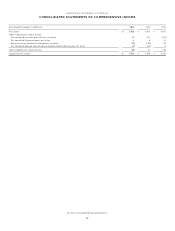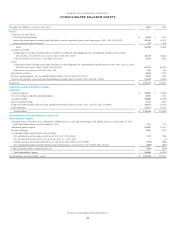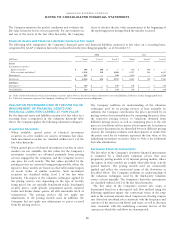American Express 2012 Annual Report Download - page 70
Download and view the complete annual report
Please find page 70 of the 2012 American Express annual report below. You can navigate through the pages in the report by either clicking on the pages listed below, or by using the keyword search tool below to find specific information within the annual report.
AMERICAN EXPRESS COMPANY
NOTES TO CONSOLIDATED FINANCIAL STATEMENTS
NOTE 2
ACQUISITIONS
On March 1, 2011, the Company completed the acquisition of a
controlling interest in Loyalty Partner, a leading marketing
services company that operates loyalty programs in Germany,
Poland, India and Mexico. Loyalty Partner also provides market
analysis, operating platforms and consulting services that help
merchants grow their businesses. Total consideration was $616
million. The Company has an option to acquire the remaining
noncontrolling equity interest (NCI) over a three-year period
beginning at the end of 2013 at a price based on business
performance, which had an estimated fair value of $148 million
at the acquisition date.
In 2010, the Company purchased Accertify and Revolution
Money for a total consideration of $151 million and $305
million, respectively. Accertify is an online fraud solution
provider and Revolution Money, which was subsequently
rebranded by the Company as Serve, is a provider of secure
person-to-person payment services through an internet-based
platform.
These acquisitions did not have a significant impact on either
the Company’s consolidated results of operations or the
segments in which they are reflected for the years ended
December 31, 2012, 2011 and 2010.
The following table summarizes the assets acquired and
liabilities assumed for these acquisitions as of the acquisition
dates:
(Millions)
Loyalty
Partner(a) Accertify
Revolution
Money(b)
Goodwill $ 539 $ 132 $ 184
Definite-lived intangible assets 295 15 119
Other assets 208 10 7
Total assets 1,042 157 310
Total liabilities (including NCI) 426 6 5
Net assets acquired $ 616 $ 151 $ 305
Reportable operating segment ICS GNMS
(a) The final purchase price allocation was completed in 2012. The above
amounts do not differ significantly from the estimates at the acquisition
date.
(b) Included in Corporate & Other.
NOTE 3
FAIR VALUES
Fair value is defined as the price that would be received to sell an
asset or paid to transfer a liability in an orderly transaction
between market participants at the measurement date, based on
the Company’s principal or, in the absence of a principal, most
advantageous market for the specific asset or liability.
GAAP provides for a three-level hierarchy of inputs to
valuation techniques used to measure fair value, defined as
follows:
폷Level 1 — Inputs that are quoted prices (unadjusted) for
identical assets or liabilities in active markets that the entity
can access.
폷Level 2 — Inputs other than quoted prices included within
Level 1 that are observable for the asset or liability, either
directly or indirectly, for substantially the full term of the asset
or liability, including:
– Quoted prices for similar assets or liabilities in active
markets
– Quoted prices for identical or similar assets or liabilities in
markets that are not active
– Inputs other than quoted prices that are observable for the
asset or liability
– Inputs that are derived principally from or corroborated by
observable market data by correlation or other means
폷Level 3 — Inputs that are unobservable and reflect the
Company’s own assumptions about the assumptions market
participants would use in pricing the asset or liability based on
the best information available in the circumstances (e.g.,
internally derived assumptions surrounding the timing and
amount of expected cash flows). The Company did not
measure any financial instruments presented on the
Consolidated Balance Sheets at fair value on a recurring basis
using significantly unobservable inputs (Level 3) during the
years ended December 31, 2012 and 2011, although the
disclosed fair value of certain assets that are not carried at fair
value, as presented later in this Note, are classified within
Level 3.
68
























